COVID-19: TCTMD’s Daily Dispatch for May Week 1
We’re curating a list of COVID-19 research and other useful content, and updating it daily.

TCTMD reporter Todd Neale is keeping up on breaking news and peer-reviewed research related to COVID-19 and will update daily. If you have something to share, tell us. All of our COVID-19 coverage can be found on our COVID-19 Hub.
May 7, 2021
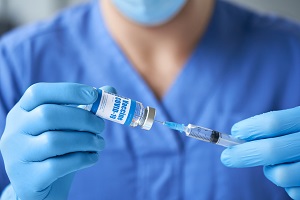 Two studies in JAMA indicate that the Pfizer/BioNTech COVID-19 vaccine reduces both symptomatic and asymptomatic infections in healthcare workers. At a tertiary medical center in Tel Aviv, Israel, symptomatic and asymptomatic infections were lower by 97% and 86%, respectively, in fully vaccinated versus unvaccinated workers. Similar but smaller reductions were seen in a study conducted at St. Jude Children’s Research Hospital in Memphis, TN. “Further research is needed to determine whether a reduction in risk of asymptomatic infection leads to reduced transmission,” the authors of the latter study write.
Two studies in JAMA indicate that the Pfizer/BioNTech COVID-19 vaccine reduces both symptomatic and asymptomatic infections in healthcare workers. At a tertiary medical center in Tel Aviv, Israel, symptomatic and asymptomatic infections were lower by 97% and 86%, respectively, in fully vaccinated versus unvaccinated workers. Similar but smaller reductions were seen in a study conducted at St. Jude Children’s Research Hospital in Memphis, TN. “Further research is needed to determine whether a reduction in risk of asymptomatic infection leads to reduced transmission,” the authors of the latter study write.
Pfizer and BioNTech have applied for full US Food and Drug Administration (FDA) approval for their COVID-19 vaccine, which is currently being used in people 16 and older under an emergency use authorization issued in December 2020, the companies announced Friday.
Public Health England (PHE) has said that a SARS-CoV-2 variant that was first detected in India and has since spread to the United Kingdom (B.1.617.2) is a variant of concern, citing evidence that it’s more transmissible, Reuters reports. Other questions remain open. “There is currently insufficient evidence to indicate that any of the variants recently detected in India cause more-severe disease or render the vaccines currently deployed any less effective,” PHE said in a statement.
The UK Joint Committee on Vaccination and Immunisation (JCVI) recommended Friday that people younger than 40 should receive a COVID-19 vaccine other than the one from University of Oxford and AstraZeneca; that recommendation previously applied to people younger than 30. The committee took into account the lower chances of a younger person becoming seriously ill with COVID-19, the availability of alternate vaccines, and the “extremely small” risk of thrombosis and thrombocytopenia with the Oxford/AstraZeneca vaccine.
Researchers report in PNAS that SARS-CoV-2 RNA can be integrated into the genome of infected cells, which “may help to explain why patients can continue to produce viral RNA after recovery” and continue to have positive PCR test results. This could have implications for clinical trials of antiviral therapies, the authors say. “If integration and expression of viral RNA are fairly common, reliance on extremely sensitive PCR tests to determine the effect of treatments on viral replication and viral load may not always reflect the ability of the treatment to fully suppress viral replication because the PCR assays may detect viral transcripts that derive from viral DNA sequences that have been stably integrated into the genome rather than infectious virus.”
 You’re not alone if you’re feeling out of sorts during the pandemic, a topic explored by NPR: “While some people who have had COVID-19 report brain fog and fatigue as lingering symptoms of their infection—what's known as long COVID—mental healthcare providers around the US are hearing similar complaints from people who weren't infected by the virus. . . . This kind of mental fog is real and can have a few different causes. But at the root of it are the stress and trauma of the past year,” according to experts. “It's a normal reaction to a very abnormal year.”
You’re not alone if you’re feeling out of sorts during the pandemic, a topic explored by NPR: “While some people who have had COVID-19 report brain fog and fatigue as lingering symptoms of their infection—what's known as long COVID—mental healthcare providers around the US are hearing similar complaints from people who weren't infected by the virus. . . . This kind of mental fog is real and can have a few different causes. But at the root of it are the stress and trauma of the past year,” according to experts. “It's a normal reaction to a very abnormal year.”
The European Medicines Agency (EMA) has started a rolling review of data on use of sotrovimab (also known as VIR-7831 and GSK4182136), a monoclonal antibody developed by GlaxoSmithKline and Vir Biotechnology, for treating COVID-19. The treatment has been shown to reduce hospitalization and death in adults with COVID-19 at high risk for hospitalization.
The EMA’s safety committee completed a review into the signal of facial swelling with the Pfizer/BioNTech COVID-19 vaccine, concluding “that facial swelling in people with a history of injections with dermal fillers should be included as a side effect.” The benefit-risk balance has not changed, the agency said. In addition, the safety committee continues to monitor whether the mRNA-based vaccines from Pfizer/BioNTech and Moderna are also associated with rare blood clots with low platelets, as has been seen with the Oxford/AstraZeneca and Johnson & Johnson (Janssen) vaccines. “Overall, the current evidence does not suggest a causal relation,” EMA said.
A Japanese town was given Covid-19 relief money. It spent $230,000 of it on a giant statue of a squid. https://t.co/gbQNguj3N7
— The New York Times (@nytimes) May 6, 2021
Several cultural landmarks in South Africa are shuttering due to the COVID-19 pandemic, Reuters reports. That includes the Apartheid Museum Johannesburg, which has had to close because it lacks the funds to operate, as well as the Fugard Theatre in Cape Town, the Johannesburg Art Gallery, and Nelson Mandela's house in the township of Soweto.
The town of Noto, Japan, spent $230,000 of COVID-19 relief funds on a 43-foot statue of a flying squid, angering some residents, the New York Times reports. The intention, however, is to bring tourism back to the town, where squid is a delicacy, after the pandemic.
May 6, 2021
There are no signs yet that India’s surge in COVID-19 cases is peaking, as there were a record 412,262 cases and 3,980 deaths reported in the country over the past 24 hours on Thursday, with the virus spreading to rural areas, Reuters reports.
 At the same time, the situation among India’s neighbors is deteriorating. The World Health Organization (WHO) said this week that Nepal’s cases increased by 137% last week, according to CIDRAP News. And, BBC News reports, there are fears of a serious COVID-19 outbreak at Mount Everest base camp. The International Federation of Red Cross and Red Crescent Societies (IFRC) released a statement on Wednesday calling for urgent international support to prevent “a worsening human catastrophe” across South Asia.
At the same time, the situation among India’s neighbors is deteriorating. The World Health Organization (WHO) said this week that Nepal’s cases increased by 137% last week, according to CIDRAP News. And, BBC News reports, there are fears of a serious COVID-19 outbreak at Mount Everest base camp. The International Federation of Red Cross and Red Crescent Societies (IFRC) released a statement on Wednesday calling for urgent international support to prevent “a worsening human catastrophe” across South Asia.
On a global scale, the number of deaths directly caused by COVID-19 is approaching 7 million, more than double the official total, according to new estimates from the University of Washington’s Institute for Health Metrics and Evaluation. The Johns Hopkins COVID-19 Dashboard puts the world total at about 3.25 million as of Thursday. As Reuters reports, “Deaths go unreported as most countries only record those that occur in hospitals or of patients with a confirmed infection, the report showed.”
Encouraging data on the effectiveness of the Pfizer/BioNTech vaccine against SARS-CoV-2 variants first detected in the United Kingdom (B.1.1.7) and South Africa (B.1.351) have come out of a real-world study in Qatar. According to data published in the New England Journal of Medicine, estimated effectiveness at least 2 weeks after the second dose was 89.5% and 75.0%, respectively, against those two variants. Protection against severe, critical, or fatal disease was even higher at 97.4%.
Also in NEJM, results from a phase IIa/b trial conducted in South Africa indicate that Novavax’s COVID-19 vaccine candidate was 51.0% effective against the B.1.351 variant among HIV-negative individuals. Reuters has more on the results.
Data from the first 4 months of Israel’s vaccination campaign, published in the Lancet, demonstrate that at 7 days or longer after the second dose of the Pfizer/BioNTech vaccine, protection against any SARS-CoV-2 infection was 95.3%, with 91.5% effectiveness against asymptomatic infection, and roughly 97.0% effectiveness against symptomatic COVID-19 and related hospitalization and death. At the time of the study, the SARS-CoV-2 variant first detected in the United Kingdom (B.1.1.7) was predominant. “These findings are of international importance as vaccination programs ramp up across the rest of the world, suggesting that other countries can similarly achieve marked and sustained declines in SARS-CoV-2 incidence if they can achieve high vaccine uptake,” the authors say.
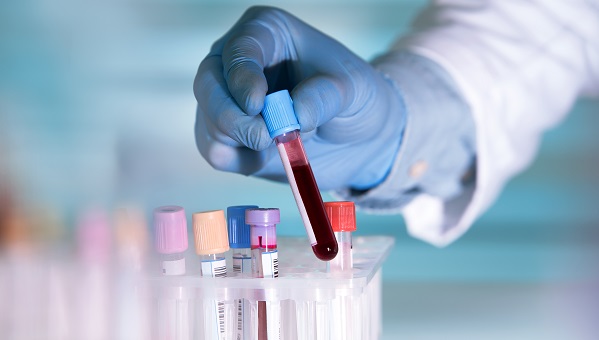 The risk of venous thromboembolic events is indeed higher after getting the COVID-19 vaccine developed by the University of Oxford and AstraZeneca, with an excess of 11 events per 100,000 shots, an analysis in the BMJ affirms. Whether the benefits of vaccination make the risks worth it depends on many factors, such as the age of the person receiving the vaccine, the availability of other vaccines, and the COVID-19 situation in the country or local region, the lead author told TCTMD. “I really stress that this is new knowledge, or rather better quantifies the knowledge we have, but how this influences the risk-benefit profile is highly country- and context-dependent, and in very many cases this will still be an overall positive vaccine,” he said.
The risk of venous thromboembolic events is indeed higher after getting the COVID-19 vaccine developed by the University of Oxford and AstraZeneca, with an excess of 11 events per 100,000 shots, an analysis in the BMJ affirms. Whether the benefits of vaccination make the risks worth it depends on many factors, such as the age of the person receiving the vaccine, the availability of other vaccines, and the COVID-19 situation in the country or local region, the lead author told TCTMD. “I really stress that this is new knowledge, or rather better quantifies the knowledge we have, but how this influences the risk-benefit profile is highly country- and context-dependent, and in very many cases this will still be an overall positive vaccine,” he said.
Moderna announced yesterday that a phase II trial showed that a single dose of its vaccine given to previously vaccinated individuals increased neutralizing antibody titer responses against SARS-CoV-2 variants first found in South Africa (B.1.351) and Brazil (P.1). A vaccine candidate matched to the B.1.351 strain induced a stronger response than a regular booster dose. The company also said Thursday that preliminary results from its phase II/III TeenCOVE show that its vaccine has an efficacy of 96% in adolescents ages 12 to 17, with no serious safety concerns.
US President Joe Biden have committed to waiving patent protections for COVID-19 vaccines in order to speed vaccinations around the world, the Washington Post reports. The pharmaceutical industry opposes the move, with the Pharmaceutical Research and Manufacturers of America (PhRMA) saying the decision “will sow confusion between public and private partners, further weaken already strained supply chains, and foster the proliferation of counterfeit vaccines.” Europe seems wary of supporting the plan, the New York Times reports. And STAT reporters discuss why the waiver of patent rights “may be more symbolic than substantive” in the short term.
 Professional sports teams/leagues are stepping up to try to encourage Americans to get their COVID-19 shots. The National Football League (NFL) announced on Wednesday that it is giving away 50 free tickets to upcoming Super Bowl LVI “for fans who share their story on why they got vaccinated or will soon get vaccinated.” And in New York, the Yankees and Mets will provide free game tickets to baseball fans who get their shots at sites set up at their respective stadiums, CBS News reports.
Professional sports teams/leagues are stepping up to try to encourage Americans to get their COVID-19 shots. The National Football League (NFL) announced on Wednesday that it is giving away 50 free tickets to upcoming Super Bowl LVI “for fans who share their story on why they got vaccinated or will soon get vaccinated.” And in New York, the Yankees and Mets will provide free game tickets to baseball fans who get their shots at sites set up at their respective stadiums, CBS News reports.
May 5, 2021
 Canada has extended authorized use of the COVID-19 vaccine from Pfizer/BioNTech to adolescents ages 12 to 15, the Associated Press reports. The US Food and Drug Administration (FDA) is expected to make a similar move in the coming days, while the European Medicines Agency (EMA) announced it’s also considering it. Pfizer expects to apply for emergency authorization for use in children ages 2 to 11 in September, the New York Times reports.
Canada has extended authorized use of the COVID-19 vaccine from Pfizer/BioNTech to adolescents ages 12 to 15, the Associated Press reports. The US Food and Drug Administration (FDA) is expected to make a similar move in the coming days, while the European Medicines Agency (EMA) announced it’s also considering it. Pfizer expects to apply for emergency authorization for use in children ages 2 to 11 in September, the New York Times reports.
Novavax announced earlier this week that it has expanded enrollment in a trial of its vaccine candidate to include up to 3,000 children between 12 and 17 years old.
The director of India’s National Centre for Disease Control said Wednesday that COVID-19 cases attributed to the SARS-CoV-2 variant first detected in the United Kingdom are on the decline, while more cases tied to a variant first seen in India are rising in some states, Reuters reports. A government advisor warned that further waves of infections are inevitable. India also issued an emergency use authorization to Roche and Regeneron for their antibody cocktail that includes casirivimab and imdevimab, which has been shown to reduce hospitalizations in high-risk COVID-19 patients. A BBC News piece explores “how India descended into COVID-19 chaos.”
US President Joe Biden announced a new goal to vaccinate 70% of American adults by July 4, which could be a challenge, the Associated Press notes: “Demand for vaccines has dropped off markedly nationwide, with some states leaving more than half their available doses unordered. Aiming to make it easier to get shots, Biden on Tuesday called for states to make vaccines available on a walk-in basis and he will direct many pharmacies to do likewise.” In addition, state vaccine allocations will be adjusted based on demand.
Denmark has excluded the Janssen COVID-19 vaccine from Johnson & Johnson from its vaccination program due to concerns about the risk of rare blood clots, with the country’s health authority saying the benefits do not outweigh those concerns, Reuters reports. Denmark had stopped using the AstraZeneca/Oxford vaccine last month for the same reason, although both vaccines will still be available on a voluntary basis. In Malaysia, the AstraZeneca/Oxford vaccine was removed from the regular rollout but will be available to people who choose to receive it.
 The small East African nation of Seychelles has been quite successful at administering COVID-19 vaccines, with more than 60% of its population being fully vaccinated. However, BBC News reports, it’s reimplementing restrictions as cases numbers rise. Among the archipelago’s 100,000 people, there have been roughly 1,000 active cases, a third of which involve people who have received two vaccine doses.
The small East African nation of Seychelles has been quite successful at administering COVID-19 vaccines, with more than 60% of its population being fully vaccinated. However, BBC News reports, it’s reimplementing restrictions as cases numbers rise. Among the archipelago’s 100,000 people, there have been roughly 1,000 active cases, a third of which involve people who have received two vaccine doses.
The pandemic has brought the US birth rate to its lowest level since federal health officials starting keeping track more than a century ago, the Associated Press reports. The rate dropped 4% last year, the biggest single-year decrease in roughly 50 years, falling in every major racial/ethnic group and in nearly every age group, according to data from the US Centers for Disease Control and Prevention (CDC).
In a European Society of Cardiology (ESC) webcast, Betty Raman, MBBS, DPhil, discusses what is known—and what remains unclear—about the possible long-term cardiovascular effects of COVID-19. “The high burden of ongoing cardiovascular symptoms is likely to place a significant demand on existing services,” she says.
 A study in Morbidity and Mortality Weekly Report (MMWR) suggests that the B.1.526 variant of SARS-CoV-2 that was first detected in New York City does not cause more-severe disease or increase the risk of infection after vaccination. Other MMWR reports detail the identification and surveillance of new variants in Colorado and model how vaccination coverage and adherence to nonpharmaceutical interventions (NPIs) might interact to affect COVID-19 activity. “Data from six models indicate that with high vaccination coverage and moderate NPI adherence, hospitalizations and deaths will likely remain low nationally, with a sharp decline in cases projected by July 2021,” the authors of the latter report write. “Lower NPI adherence could lead to substantial increases in severe COVID-19 outcomes, even with improved vaccination coverage.”
A study in Morbidity and Mortality Weekly Report (MMWR) suggests that the B.1.526 variant of SARS-CoV-2 that was first detected in New York City does not cause more-severe disease or increase the risk of infection after vaccination. Other MMWR reports detail the identification and surveillance of new variants in Colorado and model how vaccination coverage and adherence to nonpharmaceutical interventions (NPIs) might interact to affect COVID-19 activity. “Data from six models indicate that with high vaccination coverage and moderate NPI adherence, hospitalizations and deaths will likely remain low nationally, with a sharp decline in cases projected by July 2021,” the authors of the latter report write. “Lower NPI adherence could lead to substantial increases in severe COVID-19 outcomes, even with improved vaccination coverage.”
May 4, 2021
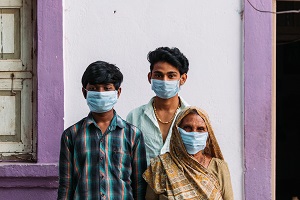 India has passed 20 million total COVID-19 cases after reporting more than 357,000 new infections over the span of 24 hours, CNBC reports. It took from late January to December 2020 to reach 10 million cases, but less than 5 months to add another 10 million. “So far, at least 222,408 people have died from the disease, but that number is likely lower than the actual death toll,” the story notes. “Media reports suggest crematoriums and burial grounds are overwhelmed with bodies of those who died from COVID-19.”
India has passed 20 million total COVID-19 cases after reporting more than 357,000 new infections over the span of 24 hours, CNBC reports. It took from late January to December 2020 to reach 10 million cases, but less than 5 months to add another 10 million. “So far, at least 222,408 people have died from the disease, but that number is likely lower than the actual death toll,” the story notes. “Media reports suggest crematoriums and burial grounds are overwhelmed with bodies of those who died from COVID-19.”
Children are making up a growing proportion of new COVID-19 cases in the United States, and it’s not just because of high vaccination rates among older people, NPR reports. On Monday, the American Academy of Pediatrics (AAP) said children accounted for 22.4% of new cases reported in the past week, up from about 3% a year ago. In addition to the vaccination of older adults, the increase can be attributed to the spread of new SARS-CoV-2 variants and the loosening of restrictions on school activities, experts say. KHN explores the increasing percentage of cases in younger and middle-age adults.
The US Food and Drug Administration (FDA) is expected to authorized the COVID-19 vaccine from Pfizer/BioNTech for use in adolescents ages 12 to 15 within a week, the Associated Press reports. Yesterday, the European Medicines Agency (EMA) said it has begun evaluating whether it will do the same. The companies announced about a month ago that the vaccine was shown to be protective and well-tolerated in that age group.
New York, New Jersey, and Connecticut are looking to lift nearly all pandemic restrictions by May 19, the New York Times reports: “The relaxation of rules starting May 19 is a testament to the fact that coronavirus cases are down and vaccination rates are rising, offering a chance to jump-start the recovery in a region that became a center of the global pandemic last spring.” The story adds, however, that some public health experts are wary of the spread of more-infectious variants and lagging vaccination rates in some groups.
 The German cabinet voted Tuesday to ease restrictions on people who are fully vaccinated or have recovered from COVID-19, Reuters reports. About 8% of people in Germany have received two vaccine doses, with more than 28% receiving a first. The cabinet’s decree must be approved by the upper and lower houses of parliament and could be in effect by the weekend, Germany’s justice minister said.
The German cabinet voted Tuesday to ease restrictions on people who are fully vaccinated or have recovered from COVID-19, Reuters reports. About 8% of people in Germany have received two vaccine doses, with more than 28% receiving a first. The cabinet’s decree must be approved by the upper and lower houses of parliament and could be in effect by the weekend, Germany’s justice minister said.
Not every part of the world is loosening up, however. Poland has strengthened its quarantine rules after cases of a SARS-CoV-2 variant first detected in India were found there, Reuters reports. The Polish health minister said people traveling to Poland from Brazil, India, and South Africa will have to quarantine regardless of test results. Singapore, too, has tightened some restrictions regarding social gatherings and border control after detecting variants, including the one first seen in India.
NPR explores how Haiti, one of the world’s poorest countries, has one of the lowest COVID-19 death rates. Through the end of April, the nation had recorded just 254 deaths, working out to a rate of 22 per million. For comparison, the rate is 1,800 per million in the United States and nearly 3,000 per million in parts of Europe. A Haitian health official said the low death rate is primarily due to a low number of COVID-19 cases since a surge last June. The story points out that most people have stopped wearing masks, public areas are crowded, and no vaccines have been administered.
The EMA has started a rolling review of the COVID-19 vaccine developed by the Chinese company Sinovac, which contains inactivated SARS-CoV-2, based on preliminary preclinical and clinical data.
 During the pandemic, adolescents living in California reduced their e-cigarette use (independent of stay-at-home restrictions) but maintained their reported use of tobacco, cannabis, and alcohol, researchers report in JAMA Pediatrics. But there was a substantial drop in physical activity after a stay-at-home order. “Interventions may be needed to ensure that physical activity levels rebound to prepandemic levels to prevent this cohort of adolescents from experiencing a premature decline in physical activity, which could track into adulthood and increase the risk for chronic disease later in life,” authors of an accompanying editorial say.
During the pandemic, adolescents living in California reduced their e-cigarette use (independent of stay-at-home restrictions) but maintained their reported use of tobacco, cannabis, and alcohol, researchers report in JAMA Pediatrics. But there was a substantial drop in physical activity after a stay-at-home order. “Interventions may be needed to ensure that physical activity levels rebound to prepandemic levels to prevent this cohort of adolescents from experiencing a premature decline in physical activity, which could track into adulthood and increase the risk for chronic disease later in life,” authors of an accompanying editorial say.
If you want to watch sports in-person, you might have to prove you’ve had your COVID-19 shots. As fans are allowed back in, many sports stadiums—including Oracle Park, the home of the San Francisco Giants, and Citi Field, home of the New York Mets—are starting to ask for proof of vaccination using an app called Health Pass by Clear, CBS News reports. The National Basketball Association (NBA) has also been using the app. “Proponents say vaccine passports are key to further reopening local economies because they are reassuring to consumers and businesses. Others argue that having to prove you've been vaccinated violates health privacy laws,” the story states, noting that some states have banned use of vaccine passports.
May 3, 2021
On Monday, India postponed exams for trainee physicians and nurses so they would be available to help battle the world’s worst flare-up of COVID-19 cases, Reuters reports. “The total number of infections so far rose to just short of 20 million, propelled by a 12th straight day of more than 300,000 new cases,” according to the story, which notes that the actual numbers in India could be five to 10 times higher.
 Costa Rica is seeing increasing COVID-19 numbers as well, threatening revival of tourism in the Central American country, Reuters reports. “Amid an April surge of COVID-19 infections, hospital beds are scarce in the tropical country. Its infection rate last week surpassed even tragedy-struck India and Brazil, according to data from Johns Hopkins University.”
Costa Rica is seeing increasing COVID-19 numbers as well, threatening revival of tourism in the Central American country, Reuters reports. “Amid an April surge of COVID-19 infections, hospital beds are scarce in the tropical country. Its infection rate last week surpassed even tragedy-struck India and Brazil, according to data from Johns Hopkins University.”
The European Medicines Agency (EMA) has begun evaluating whether use of the COVID-19 vaccine from Pfizer/BioNTech should be extended to adolescents ages 12 to 15; it’s currently authorized for use in people age 16 and up. In a press release issued at the end of March, the companies announced top-line results from study showing 100% vaccine efficacy in this age group.
According to Forbes, Canada will require a “vaccine passport” for entry into the country, with the Canadian health minister saying the government supports the idea. “Nearly eight in 10 Canadians (78%) agree (including 56% who strongly agree) that all travelers entering Canada should be required to have a vaccine passport,” according to a new Ipsos survey. Comparatively, a smaller majority of Americans (71%) agree that travelers should be required to “show a vaccine passport before entering the United States.”
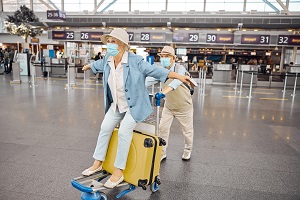 The US Transportation Security Administration (TSA) has extended a mask mandate in airports, on commercial flights, and on other forms of public transportation through September 13, NPR reports. The mandate was set to expire on May 11. “Right now, about half of all adults have at least one vaccination shot and masks remain an important tool in defeating this pandemic,” a TSA official said in a press release announcing the extension.
The US Transportation Security Administration (TSA) has extended a mask mandate in airports, on commercial flights, and on other forms of public transportation through September 13, NPR reports. The mandate was set to expire on May 11. “Right now, about half of all adults have at least one vaccination shot and masks remain an important tool in defeating this pandemic,” a TSA official said in a press release announcing the extension.
A plan announced Monday by the European Union (EU) would allow vaccinated people to travel there possibly by the end of June, the Washington Post reports: “The EU has been working for months to set up an internal system to ease travel restrictions within the 27-nation club and others that take part in its border-free travel zone. Monday’s announcement was intended to show how that system could be adapted for other countries.”
As other parts of the world continue to be hit hard by COVID-19 surges, numbers are waning in the United States, the Washington Post reports, noting that 42 states and the District of Columbia have seen lower numbers over the past 2 weeks and that the daily average of new infections across the country is the lowest it’s been since mid-October.
A study in the Lancet affirms that people from racial/ethnic minority groups have been disproportionately affected by the pandemic. In the United Kingdom, the risk of testing positive for SARS-CoV-2 during the first wave was higher in the South Asian, Black, and mixed ethnicity groups compared with white individuals. In addition, there were greater risks of COVID-19-related hospitalization, ICU admission, and death. Some of these differences were attenuated during the second wave of infections. “Tackling ethnic inequalities will require action across many fronts, including reducing structural inequalities, addressing barriers to equitable care, and improving uptake of testing and vaccination,” the authors say.
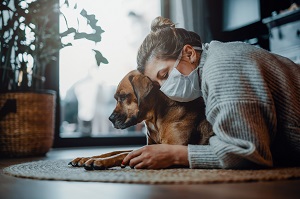 Pets in the homes of patients with COVID-19 are commonly infected with SARS-CoV-2, a study in PLOS ONE confirms. In affected households in Rio de Janeiro, Brazil, 31% of dogs and 40% of cats were infected with or seropositive for the virus. “People with COVID-19 should avoid close contact with their pets during the time of their illness,” the researchers say, noting that sharing a bed with the infected owner was associated with pet infection.
Pets in the homes of patients with COVID-19 are commonly infected with SARS-CoV-2, a study in PLOS ONE confirms. In affected households in Rio de Janeiro, Brazil, 31% of dogs and 40% of cats were infected with or seropositive for the virus. “People with COVID-19 should avoid close contact with their pets during the time of their illness,” the researchers say, noting that sharing a bed with the infected owner was associated with pet infection.
April 30, 2021
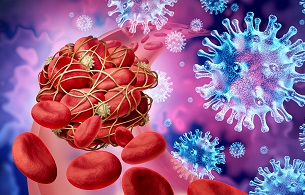 On Friday, the COVID-19 Response Team of the US Centers for Disease Control and Prevention (CDC) released multiple analyses examining the safety of the Janssen vaccine from Johnson & Johnson. One of two studies in Morbidity and Mortality Weekly Report (MMWR) showed that of the reactions recorded after nearly 8 million doses were administered, 97% were not serious, consistent with trial data. There were 17 thrombotic events with thrombocytopenia, including three that were not cerebral venous sinus thrombosis (CVST). The other MMWR analysis detailed 64 anxiety-related events, including 17 syncope cases, after receipt of the shot at five mass vaccination sites. And a third study, published in JAMA, provided information on 12 US patients who developed CVST with thrombocytopenia after receiving the Janssen shot; they were all white women, ages 18 to 60, with symptoms beginning 6 to 15 days after vaccination. As of April 21, three had died.
On Friday, the COVID-19 Response Team of the US Centers for Disease Control and Prevention (CDC) released multiple analyses examining the safety of the Janssen vaccine from Johnson & Johnson. One of two studies in Morbidity and Mortality Weekly Report (MMWR) showed that of the reactions recorded after nearly 8 million doses were administered, 97% were not serious, consistent with trial data. There were 17 thrombotic events with thrombocytopenia, including three that were not cerebral venous sinus thrombosis (CVST). The other MMWR analysis detailed 64 anxiety-related events, including 17 syncope cases, after receipt of the shot at five mass vaccination sites. And a third study, published in JAMA, provided information on 12 US patients who developed CVST with thrombocytopenia after receiving the Janssen shot; they were all white women, ages 18 to 60, with symptoms beginning 6 to 15 days after vaccination. As of April 21, three had died.
The continuing COVID-19 crisis in India is starting to have effects in surrounding countries, the Associated Press reports. India has increased production of COVID-19 vaccines and banned their export to shore up supplies, which has left neighbors like Bangladesh and Nepal—going through surges of their own—looking to China and Russia for help. On Friday, in response to the severity of the situation in India, the White House announced a ban on travel from India to the United States for anybody who is not a US citizen or permanent resident starting next Tuesday, May 4, NPR reports.
South America remains a hot spot of COVID-19 activity as well, with Brazil’s death toll rising above 400,000 on Thursday, NPR reports. That’s second only to the United States (about 576,000). “Health systems remain under intense pressure and—between the relaxation of COVID-19 measures, a sluggish vaccine rollout, and the spread of a more-contagious virus variant—experts predict the pandemic will soon get worse.” And it’s not just Brazil. The New York Times reports that deaths also have been spiking in Argentina, Columbia, Peru, Uruguay, and Venezuela.
Tanzania’s health ministry said medical oxygen production plants with the capacity to produce 200 cylinders per day have been installed in the nation’s largest hospitals to support COVID-19 patients requiring intensive care, Reuters reports. “The announcement that the plants had been installed in seven referral hospitals in a World Bank-backed project was another change of COVID-19 policies since the death of President John Magufuli in March,” according to the story, which notes that Magufuli was a COVID-19 skeptic who “urged Tanzanians to shun mask-wearing and denounced vaccines as a Western conspiracy.”
Disneyland in Anaheim, CA, reopened at limited capacity on Friday after being shuttered for 13 months, “marking a dramatic turnaround in a state that was so overwhelmed with coronavirus cases just 4 months ago that patients were being treated in gymnasiums and outdoor tents,” the Associated Press reports. Only in-state visitors will be allowed for now. Disney World’s Magic Kingdom park in Orlando, FL, has been open at limited capacity since last July.
 New York City Mayor Bill de Blasio said Thursday the city will fully reopen starting July 1, CNBC reports: “Restaurants, gyms, shops, hair salons, and arenas will open at full capacity. Smaller theaters could reopen over the summer and Broadway is on track for opening by September. Schools will be back at ‘full strength’ in the fall.”
New York City Mayor Bill de Blasio said Thursday the city will fully reopen starting July 1, CNBC reports: “Restaurants, gyms, shops, hair salons, and arenas will open at full capacity. Smaller theaters could reopen over the summer and Broadway is on track for opening by September. Schools will be back at ‘full strength’ in the fall.”
In another MMWR report, the first US clusters of SARS-CoV-2 infections caused by variant B.1.351, first identified in South Africa. Studies have suggested that current vaccines might have reduced effectiveness against this strain. Two linked clusters in Maryland involved 17 patients who did not report recent travel—two were hospitalized and one died. These cases “highlight the importance of expanding the scope and volume of genetic surveillance programs to identify variants, completing contact investigations for SARS-CoV-2 infections, and using universal prevention strategies, including vaccination, masking, and physical distancing, to control the spread of variants of concern,” the authors say.
CIDRAP News reports on two new studies affirming the link between high body mass index (BMI) and poor COVID-19 outcomes. A UK study in the Lancet Diabetes & Endocrinology showed a linear association between increasing BMI—starting as low as 23 kg/m2—and risk of severe COVID-19 resulting in hospitalization and death. And a study in Epidemiology & Infection showed that obesity was a strong risk factor for short-term mortality and adverse outcomes in Mexican patients with COVID-19.
Another study, this one from the CDC COVID-19 Response Team, has concluded that the Sturgis Motorcycle Rally held in South Dakota in August 2020, with more than 460,000 people in attendance, resulted in widespread transmission of SARS-CoV-2. According to data published in Clinical Infectious Diseases, at least 649 cases across 30 jurisdictions in the United States were tied to the event. More than half of the cases (56%) were reported in South Dakota and five bordering states (Minnesota, Montana, North Dakota, Nebraska, and Wyoming). The authors say it is likely the national impact of the event is underestimated.
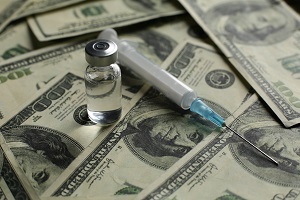 The US National Institutes of Health (NIH) announced Thursday that it is committing $29 million in additional grants to address COVID-19 disparities. “The awards will provide $15 million to 11 teams already conducting research and outreach to help strengthen COVID-19 vaccine confidence and access, as well as testing and treatment, in communities of color. An additional $14 million will fund 10 new research teams to extend the reach of COVID-19 community-engaged research and outreach.”
The US National Institutes of Health (NIH) announced Thursday that it is committing $29 million in additional grants to address COVID-19 disparities. “The awards will provide $15 million to 11 teams already conducting research and outreach to help strengthen COVID-19 vaccine confidence and access, as well as testing and treatment, in communities of color. An additional $14 million will fund 10 new research teams to extend the reach of COVID-19 community-engaged research and outreach.”
April 29, 2021
 The American Heart Association and American Stroke Association (AHA/ASA) have released a special report detailing how to diagnose and manage cerebral venous sinus thrombosis (CVST) with vaccine-induced thrombotic thrombocytopenia (VITT, also called vaccine induced prothrombotic immune thrombocytopenia, or VIPIT). In a press release issued accompanying the document, the AHA/ASA stress that the risk of CVST is eight to 10 times higher following COVID-19 itself than it is with a COVID-19 vaccine. “The likelihood of developing CVST after a COVID-19 vaccine is extremely low,” Karen Furie, MD, PhD, is quoted. “We urge all adults to receive any of the approved COVID-19 vaccines.”
The American Heart Association and American Stroke Association (AHA/ASA) have released a special report detailing how to diagnose and manage cerebral venous sinus thrombosis (CVST) with vaccine-induced thrombotic thrombocytopenia (VITT, also called vaccine induced prothrombotic immune thrombocytopenia, or VIPIT). In a press release issued accompanying the document, the AHA/ASA stress that the risk of CVST is eight to 10 times higher following COVID-19 itself than it is with a COVID-19 vaccine. “The likelihood of developing CVST after a COVID-19 vaccine is extremely low,” Karen Furie, MD, PhD, is quoted. “We urge all adults to receive any of the approved COVID-19 vaccines.”
The number of US colleges that will require students to be vaccinated if they want to return to in-person classes next fall has now passed 100, according to a New York Times survey. “More than 660,000 cases have been linked to the institutions since the start of the pandemic, with one-third of those since Jan 1,” the Times notes.
France is taking steps to gradually reopen after its third-wave lockdowns, French newspapers are reporting. As detailed on France24.com, French President Emmanuel Macron announced a four-step plan that starts with a staged reopening of schools next week and a lifting of the domestic travel ban, although curfews will remain in place. As of May 19, nonessential businesses will be allowed to reopen, the nightly curfew will be pushed to 9 PM, and restaurants and cafes will be able to have limited outdoor seating. Foreign tourists will be able to enter the country starting June 9, provided they have a certificate of vaccination or a negative PCR test.
Novelist Arundhati Roy is trending on Twitter today after her explosive opinion piece appeared in The Guardian newspaper. Decrying the handing of the COVID-19 pandemic in India, her piece is entitled: “We are Witnessing a Crime Against Humanity.” The blame, she writes, lies squarely on the country’s leaders, specifically Indian Prime Minister Narendra Modi.
 Countries that have focused on COVID-19 elimination—minimizing community transmissions—have fared better than those focused on mitigation, which try to minimize the impact on healthcare systems, write the authors of a comment in the Lancet. “Countries that opt to live with the virus will likely pose a threat to other countries, notably those that have less access to COVID-19 vaccines,” they argue. “The consequences of varying government COVID-19 responses will be long-lasting and extend beyond the end of the pandemic. Early economic and political gains made by countries aiming to eliminate SARS-CoV-2 will probably pay off in the long run.”
Countries that have focused on COVID-19 elimination—minimizing community transmissions—have fared better than those focused on mitigation, which try to minimize the impact on healthcare systems, write the authors of a comment in the Lancet. “Countries that opt to live with the virus will likely pose a threat to other countries, notably those that have less access to COVID-19 vaccines,” they argue. “The consequences of varying government COVID-19 responses will be long-lasting and extend beyond the end of the pandemic. Early economic and political gains made by countries aiming to eliminate SARS-CoV-2 will probably pay off in the long run.”
Another comment in the Lancet makes the case that any global pandemic treaty, such as the one currently being debated by the European Council, should focus on “deep prevention.” The approach would mean targeting resources to stop diseases from breaking out in the first place, rather than focusing on spread at a local, national, or international level, they write.
A survey conducted among 32,217 caregivers concludes that mental health among children was significantly adversely affected by school closures over the course of the pandemic. An editorial accompanying the study, both published in JAMA Network Open, sums up the situation bluntly: “Every district needs a plan and commitment to reopen every school, for every child, as soon as possible. Anything less is a failing grade.”
Moderna announced today that it has made “new funding commitments” to be able to increase supply in order to make up to 3 billion doses of its vaccine in 2022.
The COVID-19 pandemic produced sharp declines in cancer screening programs and while some recovery has occurred for breast, colorectal, and prostate cancer monthly screening rates, they are not yet back to prepandemic levels, a study concludes in JAMA Oncology. “Public health efforts are needed to make up the large cancer screening deficit associated with the COVID-19 pandemic,” the authors say.
Another study is probing neonatal transmission of COVID-19, following close on the heels of a study published earlier this week and reported in the Dispatch. This time around, a nationwide study in Sweden revealed that just 1.6% of live births were delivered by mothers testing positive for COVID-19, among 88,159 infants born during the study period. Infants from positive mothers were significantly more likely to have small increases in neonatal morbidities, including admission for neonatal care and respiratory problems. However, given the small numbers, the findings should be considered “exploratory,” researchers write in JAMA.
 Nostrils around the world will rejoice at the news that saliva tests for COVID-19 appear to have the same sensitivity and specificity as nasopharyngeal tests, based on a systemic review and meta-analysis. Published in JAMA Internal Medicine, the study included a total of 5,922 subjects and concluded that diagnostic accuracy is “similar” between the two tests, particularly in the ambulatory setting.
Nostrils around the world will rejoice at the news that saliva tests for COVID-19 appear to have the same sensitivity and specificity as nasopharyngeal tests, based on a systemic review and meta-analysis. Published in JAMA Internal Medicine, the study included a total of 5,922 subjects and concluded that diagnostic accuracy is “similar” between the two tests, particularly in the ambulatory setting.
TCTMD Managing Editor Shelley Wood contributed today’s Dispatch.
April 28, 2021
The death toll in India has passed 200,000, and scientists are now investigating whether a new and alarming variant may behind the crisis. “The current wave of COVID has a different clinical behavior,” Sujay Shad, MBBS, a senior cardiac surgeon at Sir Ganga Ram Hospital told the New York Times. “It’s affecting young adults. It’s affecting families. It’s a new thing altogether. Two-month-old babies are getting infected.”
Yesterday we reported that the White House had announced it would be sending millions of AstraZeneca doses overseas to help countries struggling with soaring infection rates. According to Politico, however, Biden administration officials are divided over whether they can spare any of their stockpile. “The ongoing divide raises questions about the administration’s confidence in the nation’s vaccine pipeline,” write Erin Banco and Adam Cancryn. “It also underscores the extent to which members of Biden’s pandemic response team disagree about how to protect Americans from highly transmissible virus variants while also helping countries in dire need.
 The largest study to date to track COVID-19 survivors for signs and symptoms of new-onset heart failure (HF) has found that new diagnoses are rare following hospitalization for severe SARS-CoV-2 infection, but in a small and worrying subset, HF appears to arise without any previous underlying disease or risk factors. The study was published Monday as a research letter in the Journal of the American College of Cardiology. TCTMD has the story.
The largest study to date to track COVID-19 survivors for signs and symptoms of new-onset heart failure (HF) has found that new diagnoses are rare following hospitalization for severe SARS-CoV-2 infection, but in a small and worrying subset, HF appears to arise without any previous underlying disease or risk factors. The study was published Monday as a research letter in the Journal of the American College of Cardiology. TCTMD has the story.
With 37% of the US population vaccinated and approximately 2.7 million shots taking place each day, that immune protection has helped drive down the nation’s infection rate, the Wall Street Journal reports. But the race is on, particularly as more-infectious variants accelerate. “When you get to somewhere between 40 and 50%, I believe you’re going to start seeing real change, the start of a precipitous drop in cases,” Anthony Fauci, MD, director of the National Institute of Allergy and Infectious Diseases (NIAID), said in an interview.
A study published in Morbidity and Mortality Weekly Report indicates that the Pfizer/BioNTech and Moderna mRNA vaccines were each about 94% effective in preventing COVID-19 hospitalizations among adults 65 and older who received both doses across a multistate network of US hospitals between January and March 2021. In the same age group, both vaccines appeared to be about 64% effective in adults with just one dose on board.
Canada has reported its first death of a patient who had a cerebral embolism after receiving the AstraZeneca vaccine: a 54-year-old woman in the province of Quebec. At least five patients have developed blood-clotting abnormalities linked to the shot. Quebec Health Minister Christian Dubé, quoted by Reuters, said that the province has vaccinated about 400,000 people with the AstraZeneca shot and does not have plans to change its vaccine strategy, reiterating that the reaction is rare.
The Society for Cardiovascular Angiography and Interventions (SCAI) 2021 virtual meeting kicked off today with late-breaking clinical trials that include an update from the NACMI registry of acute MI care during COVID-19. As TCTMD’s Caitlin Cox reports, the number of North American patients included in the registry, based on suspected or confirmed SARS-CoV-2 infection, is approaching 1,000.
 Informed-consent documents for COVID-19 trials are “overly long and complex,” according to an analysis published in JAMA Network Open. “These findings suggest that informed consent documents may fail to succinctly explain the studies to participants of all reading levels and that it is possible to improve these documents to increase participant accessibility.
Informed-consent documents for COVID-19 trials are “overly long and complex,” according to an analysis published in JAMA Network Open. “These findings suggest that informed consent documents may fail to succinctly explain the studies to participants of all reading levels and that it is possible to improve these documents to increase participant accessibility.
There are more signs that the COVID-19 pandemic is having an ongoing effect on medical education. A new cross-sectional study published in JAMA Network Open indicates that the number of applicants to internal medicine residency and subspecialty fellowships doubled from 2020 to 2021 as compared with any of the prior 5 years studied. Lower barriers to applying may play a role, but so too may be the spotlight COVID-19 is shining on clinical and research opportunities in certain internal medicine fields. Applications to infectious disease positions, for example, are up 17%.
A feature story in Nature explores how poverty, discrimination, and social determinants of health are responsible for the vastly unequal toll the pandemic is taking in the United States, with profound implications for low-paid agricultural workers. Amy Maxmen asks: can COVID-19 push science to finally address the issue?
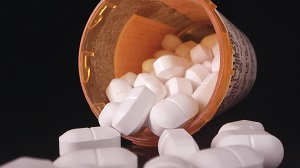 Also in Nature, a recent study reports that doctors are prescribing more and more opioids to COVID-19 “long-haulers.” For every 1,000 COVID-19 survivors with persistent symptoms “treated at a Veterans Affairs facility, doctors wrote nine more prescriptions for opioids than they otherwise would have, along with 22 additional prescriptions for benzodiazepines, which include Xanax and other addictive pills used to treat anxiety,” a KHN.org story explains.
Also in Nature, a recent study reports that doctors are prescribing more and more opioids to COVID-19 “long-haulers.” For every 1,000 COVID-19 survivors with persistent symptoms “treated at a Veterans Affairs facility, doctors wrote nine more prescriptions for opioids than they otherwise would have, along with 22 additional prescriptions for benzodiazepines, which include Xanax and other addictive pills used to treat anxiety,” a KHN.org story explains.
TCTMD Managing Editor Shelley Wood contributed today’s Dispatch.
April 27, 2021
 The United States will release 60 million doses from its stockpile of Oxford/AstraZeneca vaccines to other countries over the next few months, the Biden administration announced yesterday. The product is not authorized for use in the US, so release awaits clearance by the Food and Drug Administration (FDA), NPR reports. Last month, as noted in the Dispatch, the US released 4 million shots to neighboring Canada and Mexico.
The United States will release 60 million doses from its stockpile of Oxford/AstraZeneca vaccines to other countries over the next few months, the Biden administration announced yesterday. The product is not authorized for use in the US, so release awaits clearance by the Food and Drug Administration (FDA), NPR reports. Last month, as noted in the Dispatch, the US released 4 million shots to neighboring Canada and Mexico.
Canada announced yesterday that it is deploying its armed forces to help hospitals cope with a flood of patients in Ontario, where new cases topped 3,510 yesterday, the Globe and Mail reports.
Updated recommendations for the use of the Janssen/Johnson & Johnson vaccine from the US Centers for Disease Control and Prevention (CDC), following reports of thrombosis and thrombocytopenia, have now been published in Morbidity and Mortality Weekly Report. “Resuming use of the Janssen COVID-19 vaccine will ensure flexibility, choice, and improved access,” the authors of the report conclude.
A real-world analysis of the mass vaccine rollout in Scotland between December 8, 2020, and February 22, 2021, suggests that the Pfizer/BioNTech vaccine was 91% (95% CI 85-94%) at preventing COVID-19 hospital admissions at 28-34 days postvaccination, a rate similar to that seen, over the same study period, for the Oxford/AstraZeneca vaccine at 88% efficacy (95% CI 75-94%). Combined, the effects of both vaccines at preventing hospital admissions due to COVID-19 among people aged 80 years and older hovered in the range of 83%. Further analyses of the EAVE II database are planned to address the impact of first doses on mortality and adverse events, as well as any waning of efficacy, the authors write in the Lancet. Preprint publication of this study back in February received major media attention, including from the BMJ.
Also in the Lancet are the results of the 23,324-person SIREN trial, investigating first- and second-dose efficacy with the Pfizer/BioNTech vaccine among healthcare workers at one of 104 publicly funded hospitals in the United Kingdom. Over 2 months of follow-up, 977 new infections occurred in the unvaccinated subjects compared with just 71 new infections among those who’d received a first dose and nine new infections among those who’d received their second dose.
 The CDC has eased up somewhat on its recommendations for outdoor mask-wearing for people who are fully vaccinated. In an update to its online guidance today, the agency provides a handy graphic explaining the agency’s advice for indoor and outdoor activities, noting that fully vaccinated people don’t need to wear masks if they are doing outdoor exercise, attending small outdoor gatherings, or dining at an outdoor restaurant. Masks are still recommended, even for vaccinated individuals, for the hair salon, indoor dining, gyms, theatres, shops, museums, churches, singing, crowded outdoor events, and more.
The CDC has eased up somewhat on its recommendations for outdoor mask-wearing for people who are fully vaccinated. In an update to its online guidance today, the agency provides a handy graphic explaining the agency’s advice for indoor and outdoor activities, noting that fully vaccinated people don’t need to wear masks if they are doing outdoor exercise, attending small outdoor gatherings, or dining at an outdoor restaurant. Masks are still recommended, even for vaccinated individuals, for the hair salon, indoor dining, gyms, theatres, shops, museums, churches, singing, crowded outdoor events, and more.
The US Centers for Medicare & Medicaid Services (CMS) also recently announced that it would be increasing the Medicare payment rate for administering a COVID-19 vaccine from $28.93 per shot to $40 per shot. “Usually, CMS changes Medicare payments for specific services through notice and comment rulemaking, but to save time during the COVID-19 pandemic, the agency bypassed that route before increasing payments for administering the vaccines,” Rita Rubin writes in JAMA. “However, CMS said it continues to seek information from the public for reviewing and establishing payment rates for vaccine administration, both during the pandemic and on a longer-term basis.
An analysis of nearly 15 million people in Canada’s Ontario province confirms studies in other parts of the globe by showing that area-level social determinants of health, “including household density, essential work status, lower educational attainment, and recent immigration status,” are all associated with an increased likelihood of testing positive for SARS-CoV-2. Full results are published in CMAJ.
We previously reported in the Dispatch that less accumulation of dust and soot is believed to have reduced snow melt by virtue of being more reflective—a phenomenon seen from outer space—a rare positive impact of sweeping lockdown orders. Now researchers writing in the PNAS confirm that, yes, dust and soot concentrations are down 30% compared with the previous year averages. Moreover, relatively clean snow and ice in the Indus River Basin during the COVID-19 pandemic are likely responsible for 6.6 km3 of reduced melt in 2020 compared with the 20-year average, a finding with implications for the more than 2 billion people supplied by water from the melt.
 Investigators investigating the best treatments for anosmia—affecting up to one in five people following COVID-19 infection—say corticosteroids don’t pass the sniff test. Instead, they write in the International Forum of Allergy and Rhinology, smell-training, “a process that involves sniffing at least four different odors twice a day for several months,” is the cheapest, safest, and most effective option. A press release has the details.
Investigators investigating the best treatments for anosmia—affecting up to one in five people following COVID-19 infection—say corticosteroids don’t pass the sniff test. Instead, they write in the International Forum of Allergy and Rhinology, smell-training, “a process that involves sniffing at least four different odors twice a day for several months,” is the cheapest, safest, and most effective option. A press release has the details.
TCTMD Managing Editor Shelley Wood contributed today’s Dispatch.
April 26, 2021
The US Food and Drug Administration (FDA) and the Centers for Disease Control and Prevention (CDC) have lifted their pause on the Janssen COVID-19 vaccine from Johnson & Johnson. According to an alert issued late last Friday, the US Advisory Committee on Immunization Practices (ACIP), believes use of the vaccine “should be resumed,” and that the product is safe and effective in prevention COVID-19; moreover, the group says the risk of thrombosis-thrombocytopenia syndrome is very low.
One billion vaccinations have been given around the world, but cases continue to mount, the New York Times reports, with the Indian crisis worsening day by day.
Vaccine uptake in the over-50s has hit 95% in England, National Health Service (NHS) data show. A BBC report details the situation in different age groups, noting that among people in the 45-49 age bracket, uptake is 59% (having only become eligible earlier this month) and hovers around 80% among care home staff. Encouragingly, the article says, “coronavirus was not the leading cause of death in England and Wales in March, for the first time since October.”
The European Union (EU) executive branch—the European Commission (EC)—is suing AstraZeneca over its failure to deliver promised doses and for not having a “reliable” plan for timely vaccine deliveries, the BBC reports. The EU had a deal for 300 million doses, but of 80 million doses promised for delivery in the first 3 months of 2021, only about 30 million were actually sent.
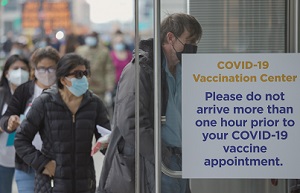 The European Commission is also mulling a plan to lift a year-long ban on US travelers visiting 27 member states, so long as they are vaccinated, EC President Ursula von der Leyen told the New York Times on Sunday. Eligibility is expected to be limited to use of vaccines that are also approved in Europe and would use some form of “vaccine passport,” the article explains.
The European Commission is also mulling a plan to lift a year-long ban on US travelers visiting 27 member states, so long as they are vaccinated, EC President Ursula von der Leyen told the New York Times on Sunday. Eligibility is expected to be limited to use of vaccines that are also approved in Europe and would use some form of “vaccine passport,” the article explains.
Months after an acute COVID-19 infection, the risk of acute ischemic stroke (AIS) remains elevated, a case series from Singapore published in JAMA Network Open hints. Among a staggering 54,485 COVID-19 cases among men living in dormitory conditions, made up primarily of South Asian migrant workers, 18 presented with AIS.
Stay-at-home orders tracked closely with increases in opioid overdose fatalities in Cook Country, IL, a JAMA analysis notes. Following December 2019, deaths increased from a mean of 23 per week to a mean of 35.1 per week, then reached 44.1 weekly deaths at their peak. While fatalities dropped again when the stay-at-home orders were lifted, they have not returned to prepandemic levels, investigators warn.
UK researchers writing in Science describe the merits of the REACT-1 community surveillance program, which used self-administered swabs from 594,000 individuals to detect a summer decline and a fall uptick, even among asymptomatic people. “When compared to cases detected through routine surveillance, we report here a longer period of decline and a younger age distribution,” the write. “Representative community sampling for SARS-CoV-2 can substantially improve situational awareness and feed into the public health response even at low prevalence.”
 A viewpoint in JAMA explores the ways clinical trials have been impacted by and adapted to the COVID-19 era, noting that some of these “alternative clinical trial methods could remain, potentially facilitating trial participation for individuals with multiple comorbid health conditions, for whom travel to a medical center is difficult.” A feature story on TCTMD late last year also probed this topic.
A viewpoint in JAMA explores the ways clinical trials have been impacted by and adapted to the COVID-19 era, noting that some of these “alternative clinical trial methods could remain, potentially facilitating trial participation for individuals with multiple comorbid health conditions, for whom travel to a medical center is difficult.” A feature story on TCTMD late last year also probed this topic.
Maternal-fetal transmission of COVID-19 was rare among a cohort of 250 mothers across 11 US hospitals who tested positive for the illness just prior to or after delivery—only 2.2% among 88.2% of newborns tested during hospitalization after birth. But babies who tested positive did have direct and indirect adverse health outcomes, typically related to preterm delivery prompted by worsening maternal COVID-19 illness. Importantly, maternal social vulnerability increased the risk for neonatal test positivity, investigators write in JAMA Network Open.
Results of the randomized TOGETHER trial, testing hydroxychloroquine or lopinavir-ritonavir administered as a 9-day course to reduce COVID-19-associated hospitalization or death, have now been published in JAMA Network Open. Among 685 out of the intended 1,476 subjects—trial enrollment was stopped after an interim analysis indicated futility—neither of the two agents showed any significant effect on decreasing hospitalizations or any other secondary outcome.
 Individuals who recovered from a SARS-CoV-2 infection then subsequently received the Pfizer/BioNTech vaccine showed a significantly higher spike specific T-cell and antibody response following vaccination than did vaccinated individuals who did not have prior COVID-19 diagnosis. However, vaccinated people appear to generate a T-cell and antibody response comparable to that seen within weeks or months following a “natural infection.” The upshot, investigators write in a Lancet preprint: “Two exposures to SARS-CoV-2 by either natural infection and one dose of the [Pfizer/BioNTech] vaccine or by two vaccine doses in naive individuals induce high levels of anti-spike T cell responses, with higher IgG antibodies in those with previous infection compared to naive people with one or two doses of vaccine.”
Individuals who recovered from a SARS-CoV-2 infection then subsequently received the Pfizer/BioNTech vaccine showed a significantly higher spike specific T-cell and antibody response following vaccination than did vaccinated individuals who did not have prior COVID-19 diagnosis. However, vaccinated people appear to generate a T-cell and antibody response comparable to that seen within weeks or months following a “natural infection.” The upshot, investigators write in a Lancet preprint: “Two exposures to SARS-CoV-2 by either natural infection and one dose of the [Pfizer/BioNTech] vaccine or by two vaccine doses in naive individuals induce high levels of anti-spike T cell responses, with higher IgG antibodies in those with previous infection compared to naive people with one or two doses of vaccine.”
TCTMD Managing Editor Shelley Wood contributed today’s Dispatch.
Todd Neale is the Associate News Editor for TCTMD and a Senior Medical Journalist. He got his start in journalism at …
Read Full Bio


Comments